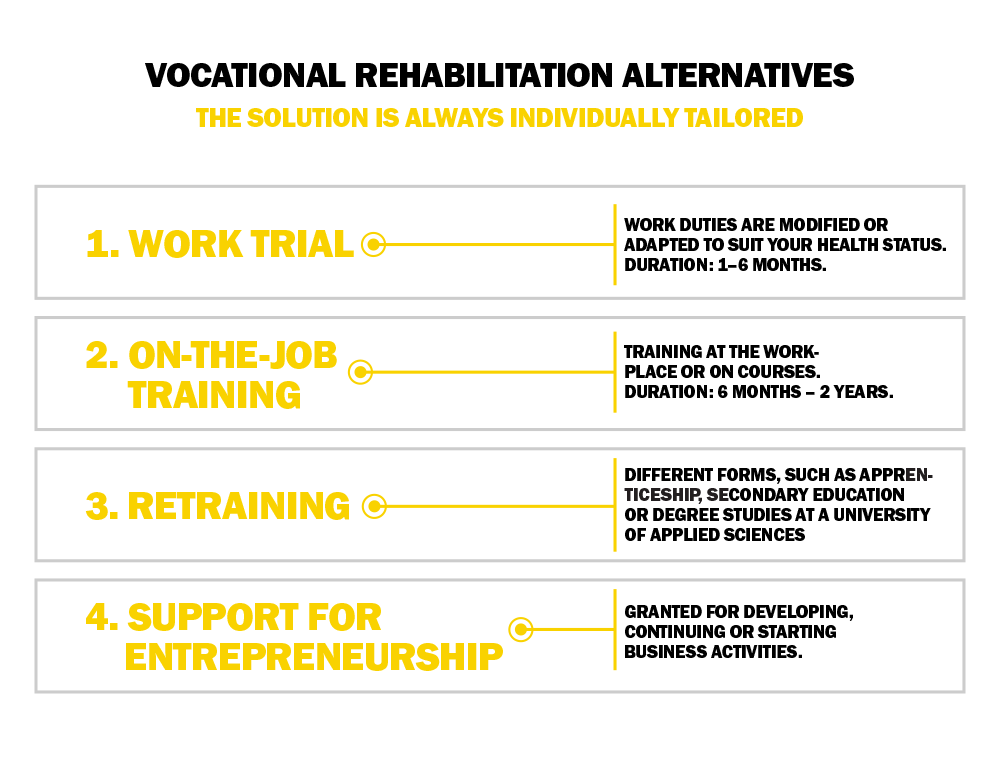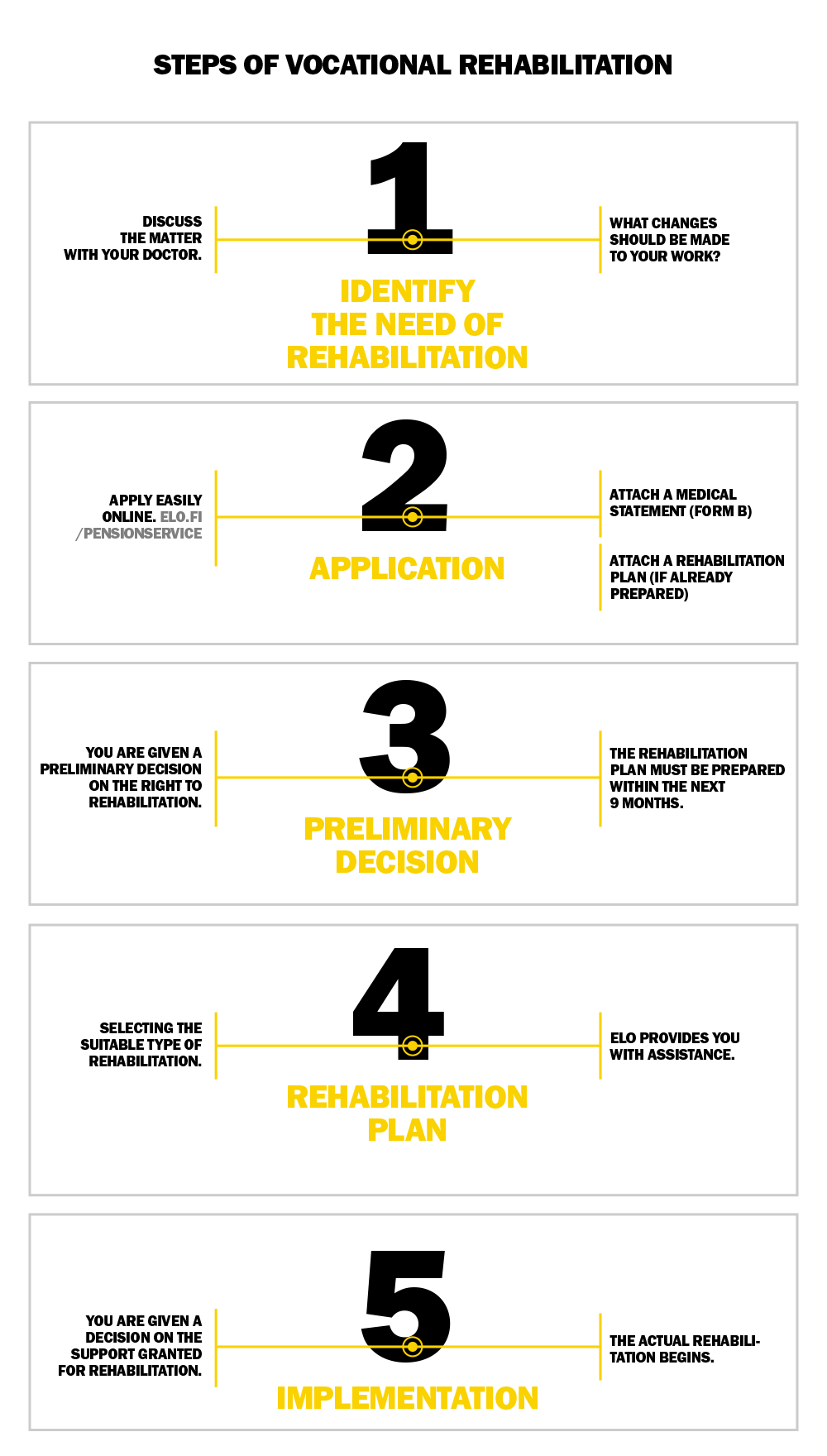What vocational rehabilitation means, and 7 other important questions
/ Article
The majority of those who have received vocational rehabilitation will be able to continue in working life.
Vocational rehabilitation is an effective route for a return to working life. Rehabilitation will provide you with tools to cope at work and continue in working life if an illness, injury or disability makes it difficult for you to manage in your current work.
Seven out of 10 persons who have taken part in rehabilitation are able to continue in working life.
Riikka Kivirikko-Ekman, Rehabilitation Manager at Elo, responds to eight questions typically presented about vocational rehabilitation.
1) What is the idea behind vocational rehabilitation?
Vocational rehabilitation is intended to provide an individual with support for coping at work. Your current work tasks or occupation will be adapted or modified so as to enable you to continue in working life despite your health issues.
Rehabilitation may be carried out in different ways, for example, through a transfer from a heavily loading job to a lighter work. Sometimes the only option is retraining for a totally new occupation.
Vocational rehabilitation may be used to support an individual’s return to work after a long sick leave. Rehabilitation may also offer a route back to working life from a temporary disability pension.
2) For whom is vocational rehabilitation intended?
Vocational rehabilitation is a feasible option both for employees and entrepreneurs. It is intended for persons whose work ability has declined and who have not yet reached their pensionable age. The earliest age at which you can retire with old-age pension depends on your birth year.
Declined work ability means that the person in question no longer managed to perform at work due to a health issue. Musculoskeletal disorders are a common cause of declined work ability.
For a person to receive vocational rehabilitation, the threat of disability must have been diagnosed by a doctor. In other words, the work ability must have declined to such an extent that, without rehabilitation, the individual would be forced to retire with disability pension in the next years.
Elo can support your vocational rehabilitation if
- you have not reached your lowest pensionable age,
- you are facing the threat of disability pension in the near future,
- you have several years of vocational experience and work history,
- your earned income from the preceding 5 years totals a minimum of 36,342.90 euro (in 2020),
- you are not entitled to vocational rehabilitation granted on the basis of an injury or traffic accident, and
- you are still working as an employee or entrepreneur, or a relatively short time has elapsed since the termination of your employment or entrepreneurial activities.
3) How do I know if vocational rehabilitation is suitable for me?
The occupational health service plays a key role in terms of guiding persons to rehabilitation. Thus, you should always first discuss the option of vocational rehabilitation with your occupational health service or other health-care professional.
If, as an entrepreneur, you have no occupational health service arranged for yourself, you can discuss the matter with a doctor at your local health centre.
There are some signs of possibly declined work ability that you can identify yourself:
- You have a history of multiple sick leaves.
- It has become hard for you to cope at work.
- Your work is exhausting – you have no energy left to do anything after work.
Due to declined work ability, it may be extremely strenuous for an entrepreneur to successfully run the business. In many cases, rehabilitation or adaptation of work make it possible to continue entrepreneurial activities.
Be active! The earlier you identify and respond to the need of rehabilitation, the better the outcome.
4) What alternatives does vocational rehabilitation offer?
Vocational rehabilitation offers four different alternatives. In any case, the solution is always individually tailored on the basis of your health status and earlier education and work history. Various rehabilitation methods are assessed in relation to the risk of disability.
Vocational rehabilitation may be implemented in different forms, for example, through modification of work tasks in the current workplace or retraining for a totally new occupation. All alternatives are suitable for entrepreneurs as well.
There is no need for you to try to figure out which type of rehabilitation is optimal for you; the matter will be decided when the rehabilitation plan is being drawn up. Elo can provide you with assistance for drawing up the plans.

Click on the image to enlarge it.
Vocational rehabilitation may be implemented in the form of work trial. The idea is to modify and adapt your work duties to better match your health status. The duration of a work trial period is 1–6 months, with 3 months being a typical solution.
The work trial usually begins with reduced working hours, for example, 4 hours/day or 20 hours/week. As the work trial proceeds, the number of working hours is gradually increased to reach the maximum of 40 hours/week at the end of the work trial period.
On-the-job training has a longer duration, usually from 6 months up to 2 years. This type of vocational rehabilitation always includes training, either at the workplace or on courses. This is a feasible option if, for example, you are returning to work for your current employer but in completely new tasks, which require new skills and competences.
Retraining may be a feasible alternative if it is not possible to adapt or modify your work tasks or job description to suit your health status. Retraining may offer a more long-ranging solution than a work trial or on-the-job training.
Different forms of training include, for example, apprenticeship, secondary education or even a degree from a university of applied sciences. The purpose of retraining is to provide you with a vocation or occupation that suits your current health status.
Another alternative, available for self-employed persons, is the support for entrepreneurship, which can be granted for the purposes of developing, continuing or starting business activities. The support for entrepreneurship can be used, for example, to cover expenses for acquiring tools, devices or machines to facilitate work, or for the necessary changes required in order to continue business activities, including reasonable costs for renovation of premises.
Prior to granting support for entrepreneurship, the conditions of the company to continue business will always be assessed. The aim is to modify the business activities so that the entrepreneur will cope at work in the future in terms of prevailing health status.
5) How do I apply for vocational rehabilitation?
Once you have, jointly with the occupational health service or a doctor, identified the need for rehabilitation, you can submit an application for a preliminary decision concerning vocational rehabilitation.
You can submit the application through Elo’s online Pension Service. You must attach a medical statement (Form B) to the application, indicating the diagnosed threat of disability. You can also choose to apply for rehabilitation by mailing an application form.
When you are applying for a preliminary decision, no rehabilitation plan is required yet. If, however, you already have a clear idea of how you wish to proceed, you can include the plan in the application.
The rehabilitation decision is always dependent on the applicant’s health status as well as previous education and work history. Think about your work and how it should be changed in order to better suit for your current health.
A preliminary decision does not yet mean that you are entitled to receive rehabilitation. After receiving the preliminary decision, you should draw up a rehabilitation plan within the next 9 months. Elo can provide you with assistance in this matter. We will also help you in developing the plan so that it will be supportable.
When the rehabilitation plan is completed, you can apply for a decision on its implementation through Elo’s online Pension Service. Once you have received the decision, your rehabilitation can begin.

Click on the image to enlarge it.
6) I applied for disability pension but received a decision on vocational rehabilitation. Why?
When a disability pension decision is being made for an individual person, it is necessary to assess if the individual’s work ability could be affected through vocational rehabilitation. If the insurance physician estimates that it is a feasible option, the applicant will receive a decision on vocational rehabilitation, even if it had not been applied for.
The rehabilitation decision is always dependent on the applicant’s health status as well as previous education and work history.
Vocational rehabilitation is always a better option than disability pension, financially as well as in other terms. To check the estimated amounts of rehabilitation allowance and disability pension payable to you, go to Elo’s online Pension Service [linkki]. The difference is significant.
Vocational rehabilitation offers you the possibility of continuing in gainful employment and accruing old-age pension by finding a job or tasks suitable for your health. This way, you can also develop your competences and remain a member of work community.
7) I received a decision on rehabilitation even though I did not apply for such. What should I do?
Please contact Elo and we will assist you onward.
A preliminary decision does not yet mean that you are entitled to vocational rehabilitation. You have now 9 months to draw up a rehabilitation plan. We will be happy to help you with that.
When your rehabilitation plan is complete, you can apply for a decision on its implementation through Elo’s online Pension Service. Once you have received the decision, your rehabilitation can begin.
8) How do I get by during the rehabilitation?
During the period of vocational rehabilitation, you will be paid either rehabilitation allowance or rehabilitation benefit increased by a 33 percent rehabilitation increment. The rehabilitation allowance is the more commonly applied alternative.
Rehabilitation allowance is paid to a person who is not on a temporary disability pension at the time the implementation of the rehabilitation plan begins. The amount of rehabilitation allowance is comprised of the calculated disability pension increased by a 33% increment. Usually, the sum is equal to approx. 75% of the person’s pay.
If you are, at the time the rehabilitation begins, on a temporary disability pension, in other words, you are receiving rehabilitation benefit, you will be granted an additional rehabilitation increment. It equals to 33% of your full disability pension.
The amount of rehabilitation benefit depends on the amount and duration of the applicant’s income, especially over the preceding 5 years prior to the date of falling ill.
The rehabilitation allowance or rehabilitation increment is not paid until during the implementation of the rehabilitation. Thus, they are not yet paid on the basis of a preliminary decision.
Moreover, during the rehabilitation, the necessary study and travel costs will be compensated in accordance with the recommendations of the Finnish Pension Alliance TELA.
Apply for rehabilitation through Elo’s online Pension Service >